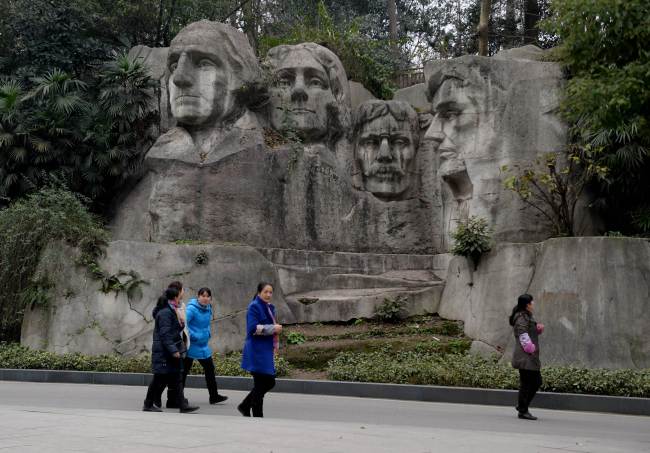CHONGQING, China (AFP) ― Already renowned for copying Western goods from trainers to champagne, China is building up its replica reputation with a miniature Mount Rushmore, Eiffel Tower and an entire Austrian village.
The reproduced structures ― also dubbed “duplitecture” ― can appear bizarre to outsiders but make sense to many in the country.
“I think it’s a good thing. I can see things from places that I’ve never been,” said a man surnamed Fu, 32, sitting in a Chongqing park scattered with sculptures including Michelangelo’s David, Rodin’s Thinker and the gigantic heads of four American presidents.
Elsewhere in the southwestern city a set of curved white buildings under construction have sparked controversy for their striking resemblance to a Beijing development by star British architect Zaha Hadid.
 |
| This photo shows people walking past a copy of Mount Rushmore at a park in Chongqing. (AFP-Yonhap) |
Copying was “something China does,” a retired judge said as she walked past the site, adding: “I think it’s a good thing ― we can learn from the experience of others.”
The director of Hadid’s Beijing project was less positive, reportedly calling the property company “pirates.” It has denied copying and told AFP it had reached an agreement with the original developer, which declined to comment.
The “duplitecture” trend developed alongside China’s real estate boom in recent decades, especially for creations conveying prestige and success, said Bianca Bosker, the New York-based author of “Original Copies: Architectural Mimicry in Contemporary China.”
Among the most eye-popping examples are a copy of the Austrian alpine village and Unesco World Heritage Site of Hallstatt in the southern province of Guangdong, which even the official news agency Xinhua called “a bold example of China’s knock-off culture.”
An assemblage of Parisian monuments including the Eiffel Tower and a fountain from Versailles stand in Hangzhou, as does a French village.
Hebei province has an imitation Sphinx, while outside Shanghai sits Thames Town, an English-themed suburb featuring a statue of Winston Churchill, a church from Bristol and lookalikes of guards at Buckingham Palace.
The imitations are open to mockery, but Bosker says that such replicas provide an easy way to convey prestige on a huge scale.
“In the U.S. we see people who copy as unimaginative thieves. In China copiers have been viewed with more nuance ― copying can be a sign of skill and it can also just be a really practical solution to a problem,” she told AFP.
“Developers wanted a way to brand their developments and the home owners wanted a way to brand their lifestyle and their economic success.
“And one of the easiest solutions to that was to copy architecture that was most emblematic of a kind of aristocratic and ‘sophisticated’-seeming lifestyle,” she said, citing Versailles, Venice and the White House as popular models.
That pragmatic streak also drives the mass production of knockoffs including Italian handbags, Swiss watches, French wine, Hollywood films and iPhones, while the southwestern city of Kunming once even hosted a fake Apple store.
In Dafen, part of the boom town of Shenzhen next to Hong Kong, an army of artists duplicate masterpieces ranging from Vincent van Gogh to Jackson Pollock.
The fakes allow Chinese to enjoy what they could not otherwise afford, said a young man strolling at an amusement park in Chongqing featuring a miniature New York, Venice-like canals and Rio de Janeiro’s Christ the Redeemer statue rotating atop a ride.
“In terms of respecting others’ creativity, it’s not okay. But for a China that’s still developing, for a certain time there’s a use for it,” he said.
“When China’s economy becomes developed enough, then there won’t be a market for copied goods.”
Even so the rampant imitation raises questions of national pride in a country boasting a rich history and now regaining global clout.
In March Renmin University president Chen Yulu urged his countrymen to “refrain from copying European architectural styles and work harder to promote local culture“, Xinhua paraphrased him as saying, while itself warning of an “eerie copycat architectural landscape.”
As China rises in stature and wealth it will increasingly seek inspiration from within, said Bosker, adding that already “there seems to be a new confidence and interest in their own indigenous styles.”
At the park with the Mount Rushmore replica, a man in his 20s surnamed Mao argued that China’s neighbors mimicked its culture when it held greater sway in the past, and would do so again as the country reclaims the stage.
“If people have something good then we will copy it,” he said. “This is something every country, every society does, not only China.”
But a 27-year-old woman surnamed Huang, walking past the fake Manhattan with a friend, said her compatriots should embrace their own heritage.
“It seems like Chinese people have this view that anything foreign is good, that anything with English writing, whether or not they can read it, is good,” she said.
“China is not inferior to anyone, but nobody really cares a lot about China’s ancient past.”

